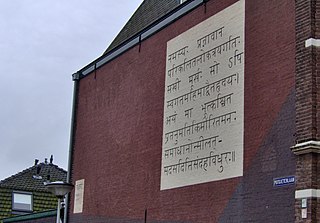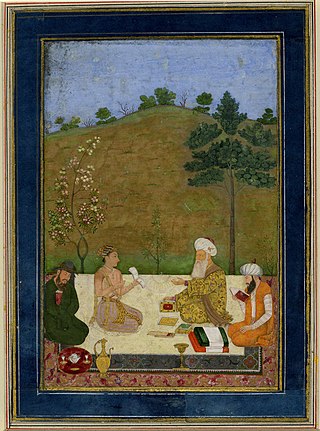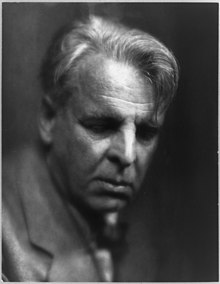
William Butler Yeats was an Irish poet, dramatist and writer, and one of the foremost figures of 20th-century literature. He was a driving force behind the Irish Literary Revival, and along with Lady Gregory founded the Abbey Theatre, serving as its chief during its early years. He was awarded the 1923 Nobel Prize in Literature, and later served two terms as a Senator of the Irish Free State.

The Upanishads are late Vedic and post-Vedic Sanskrit texts that "document the transition from the archaic ritualism of the Veda into new religious ideas and institutions" and the emergence of the central religious concepts of Hinduism. They are the most recent addition to the Vedas, the oldest scriptures of Hinduism, and deal with meditation, philosophy, consciousness, and ontological knowledge. Earlier parts of the Vedas dealt with mantras, benedictions, rituals, ceremonies, and sacrifices.

The Brahmanas are Vedic śruti works attached to the Samhitas of the Rig, Sama, Yajur, and Atharva Vedas. They are a secondary layer or classification of Sanskrit texts embedded within each Veda, which explain and instruct on the performance of Vedic rituals. In addition to explaining the symbolism and meaning of the Samhitas, Brahmana literature also expounds scientific knowledge of the Vedic Period, including observational astronomy and, particularly in relation to altar construction, geometry. Divergent in nature, some Brahmanas also contain mystical and philosophical material that constitutes Aranyakas and Upanishads.
The Oxford Book of Modern Verse 1892–1935 is a poetry anthology edited by W. B. Yeats and published in 1936 by Oxford University Press. A long introductory essay starts from the proposition that the poets included should be all the "good" ones active since the death of Tennyson. In fact, the selection of poets is idiosyncratic: late Victorians are strongly represented, while the war poets of the First World War are not. The modernist tendency does not predominate, though it is not ignored; Georgian poetry is covered quite thoroughly; and Oliver St. John Gogarty is given space and praised in the introduction as a great poet.
Shri Purohit Swami was a Hindu teacher from Maharashtra, India.
Marguerite "Margot" Ruddock (1907–1951), who used the stage name Margot Collis, was an English actress, poet and singer. She had a relationship with W. B. Yeats starting in 1934. Their correspondence was published as Ah, Sweet Dancer (1970).
The Cuala Press was an Irish private press set up in 1908 by Elizabeth Yeats with support from her brother William Butler Yeats that played an important role in the Celtic Revival of the early 20th century. Originally Dun Emer Press, from 1908 until the late 1940s it functioned as Cuala Press, publicising the works of such writers as Yeats, Lady Gregory, Colum, Synge, and Gogarty.
Swami Gambhirananda (1899–1988), born as Jatindranath Datta, was a Hindu sanyasi associated with Ramakrishna Mission. He was born at Sadhuhati in today's Bangladesh. He graduated from Scottish Church College, Calcutta (Kolkata).

The Isha Upanishad, also known as Shri Ishopanishad, Ishavasya Upanishad, or Vajasaneyi Samhita Upanishad, is one of the shortest Upanishads, embedded as the final chapter (adhyāya) of the Shukla Yajurveda. It is a Mukhya Upanishad, and is known in two recensions, called Kanva (VSK) and Madhyandina (VSM). The Upanishad is a brief poem, consisting of 17 or 18 verses, depending on the recension.

The Mandukya Upanishad is the shortest of all the Upanishads, and is assigned to Atharvaveda. It is listed as number 6 in the Muktikā canon of 108 Upanishads.

Sanskrit has been studied by Western scholars since the late 18th century. In the 19th century, Sanskrit studies played a crucial role in the development of the field of comparative linguistics of the Indo-European languages. During the British Raj (1857–1947), Western scholars edited many Sanskrit texts which had survived in manuscript form. The study of Sanskrit grammar and philology remains important both in the field of Indology and of Indo-European studies.

The Katha Upanishad, is an ancient Hindu text and one of the mukhya (primary) Upanishads, embedded in the last eight short sections of the Kaṭha school of the Krishna Yajurveda. It is also known as Kāṭhaka Upanishad, and is listed as number 3 in the Muktika canon of 108 Upanishads.
Principal Upanishads, also known as Mukhya Upanishads, are the most ancient and widely studied Upanishads of Hinduism. Composed between 800 BCE to the start of common era, these texts are connected to the Vedic tradition.
The Shanti Mantras, or Pancha Shanti mantras, are Hindu prayers for peace (shanti) found in the Upanishads. Generally, they are recited at the beginning and end of religious rituals and discourses.
This is a list of all works by Irish poet and dramatist W. B. Yeats (1865–1939), winner of the 1923 Nobel Prize in Literature and a major figure in 20th-century literature. Works sometimes appear twice if parts of new editions or significantly revised. Posthumous editions are also included if they are the first publication of a new or significantly revised work. Years are linked to corresponding "year in poetry" articles for works of poetry, and "year in literature" articles for other works.
Sri Anirvan, born Narendra Chandra Dhar, was an Indian Hindu monk, writer and philosopher. Widely known as a scholar, his principal works were a Bengali translation of Sri Aurobindo's The Life Divine and the three-volume treatise Veda Mimamsa.

Olivia Shakespear was a British novelist, playwright, and patron of the arts. She wrote six books that are described as "marriage problem" novels. Her works sold poorly, sometimes only a few hundred copies. Her last novel, Uncle Hilary, is considered her magnum opus. She wrote two plays in collaboration with Florence Farr.

Charles Johnston was an Irish writer, journalist, theosophist, naturalist, and Sanskrit scholar. Johnston joined the Indian Civil Service in 1888 but left India after two years due to malaria and settled in the United States in 1896. He wrote numerous books on Indian philosophy, translating works from Sanskrit as well as on Theosophy. He was married to the niece of Madame Blavatsky and was involved in the development of the Theosophical Society in the United States.
Mina Cho is a South Korean poet, critic, lecturer, and teacher.

The Sirr-i-Akbar is a version of the Upanishads authored by the Mughal-Shahzada Dara Shukoh, translated from Sanskrit into Persian, c. 1657. After years of Sufi learning, Dara Shukoh sought to uncover a common mystical language between Islam and Hinduism, boldly stating that the Kitab al-Maknun, or "Hidden Book", mentioned in the Qur'an is none other than the Upanishads.










